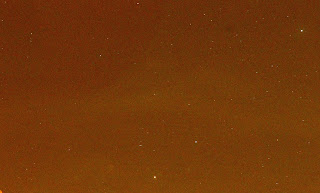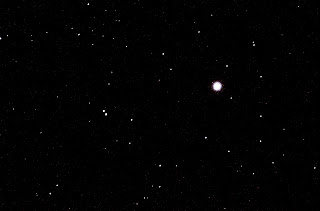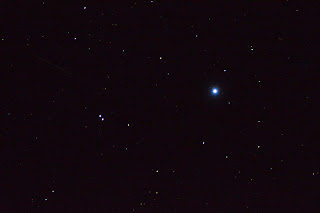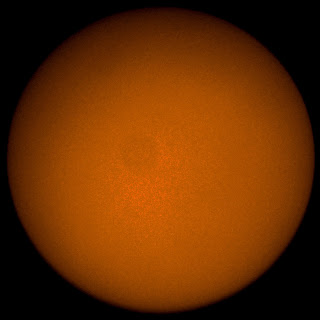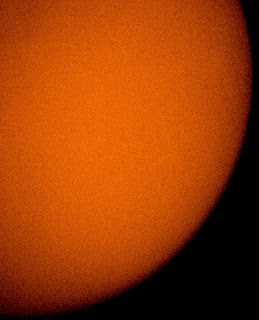May 27th 2215 GMT
May 27th 2215 GMT
My original plan was to have a webcam session with Jupiter. Unfortunately, I was aching from gardening, so I decided to do a camera shoot instead. I used a focal length of 100mm, ISO 6400 and 8 seconds exposure.
Melotte 111
Despite taking over 30 frames and 52 dark frames, neither Deep Sky Stacker (DSS) nor Microsoft ICE could stack them, so I just processed a single frame.
Lyra
DSS stacked 9 out of 14 frames and gave me my best shot of the constellation ever.Cygnus near Deneb
DSS stacked 13 frames of 19 but left a blank result. Microsoft ICE stacked 3 frames.Antares
DSS "stacked" the images but just produced horizontal lines. I stacked in Microsoft ICE and captured a globular star cluster, probably M4. I wondered how it would have looked from a more southern location.May 27th 2110 GMT
I snapped the waxing crescent Moon. I used ISO 400 30mm focal length and 1/1000 second exposure. I did not get an image until I reached ISO 1600.
May 26th 2200 GMT
My first proper bin scanning session of the year (even though it wasn't quite dark) started off with Jupiter but I found it hard to see any moons. I caught Melotte 111 and even the Beehive (M44) was quite clear in late May. I saw the International Space Station (ISS) pass up to about 45 degrees above the horizon before it disappeared into Earth's shadow. I even saw two satellites pass each other in the same binocular field of view while I was taking photos with a remote shutter release.
I caught the summer double stars: Albireo Epsilon and Delta Lyrae and Nu Draconi. Looking for Albireo was especially fun. as it took me through lots of Milky Way background stars.
I did a photo shoot at 300mm ISO 6400 and 2 seconds exposure. My targets were:
Jupiter:
Deep Sky Stacker (DSS) only stacked one frame (of 21) but with no less than 44 (!!) dark frames I continued. A little but of tweaking with GIMP and I caught two moons. I also tried stacking only the best 70% of frames but didn't think it made any difference here.
Beehive (M44):
DSS stacked 14 of 31 frames and gave a rather nice result. Well, I get it right sometimes.
Melotte 111:
I didn't get this right! I was simply unable to get the whole object in the camera view and the result was not aesthetically pleasing in its own right.
Saturn:
I was surprised that I captured no sign of the rings whatsoever. I didn't get Titan either and the planet was so low down, that was no surprise. I saw little point in processing and posting a bright dot with few background stars.
Albireo:
Despite being magnitude 3.1, Albireo can sometimes be a difficult object in a camera viewfinder. This attempt was no exception and I just caught the same part of sky I caught the week before.2 out of 5? Poor but at least I had a nice bin scan and I felt pleased with the M44 shot.
May 26th 0805 GMT
I bin scanned the Sun in a clear sky and saw what appeared as a single sunspot, although the Big Bear observatory showed it to be a small sunspot group.
May 21st 1530 GMT
Conditions were hazy but I checked the Sun in hydrogen alpha light with my Coronado PST anyway. The Sun looked very quiet and I was only able to take a set of full disc shots before cloud rolled in.
May 21st 1030 GMT
I caught a gap in clouds and took some full disc shots of the Sun with my Mak and DSLR. I used ISO 400 and 1/4000 second exposure.
May 21st 2330 GMT
Totally against the weather forecast, the sky was clear, with haze in parts. I set up my DSLR at 300mm focal length, ISO 6400 and 2.5 seconds exposure. I snapped Jupiter, Albireo, Vega (with Epsilon Lyrae), Deneb and Arcturus. By the time I had finished, cloud covered most of the sky and haze covered the rest. I took 40 dark frames and I usually find taking more dark frames helps.
Jupiter: Deep Sky Stacker (DSS) only processed one frame. I finished in GIMP but could not remove the haze around the planet.
Jupiter: Deep Sky Stacker (DSS) only processed one frame. I finished in GIMP but could not remove the haze around the planet.
Albireo:
I'm not sure I caught it and I think this is another part of sky. DSS stacked 5 frames of 9 and the final image was good. I managed to do a lot of brightening in GIMP.
Vega and Epsilon Lyrae: DSS processed only one frame but I was able to brighten it to reveal more stars.
Deneb: as above
The Arcturus shot was composed of 8 frames.
One Deneb frame had a meteor.
Finally, I caught a sequence of satellite trails on the Vega shots. The difference is that a satellite trail can be seen over consecutive frames but a meteor trail can not.
I'm not sure I caught it and I think this is another part of sky. DSS stacked 5 frames of 9 and the final image was good. I managed to do a lot of brightening in GIMP.
Vega and Epsilon Lyrae: DSS processed only one frame but I was able to brighten it to reveal more stars.
Deneb: as above
The Arcturus shot was composed of 8 frames.
One Deneb frame had a meteor.
Finally, I caught a sequence of satellite trails on the Vega shots. The difference is that a satellite trail can be seen over consecutive frames but a meteor trail can not.
May 19th 2250 GMT
I left a camera out at 18mm ISO 400 and bulb exposure in an attempt to capture star trails. The exposure was about 40 minutes and it was partially ruined by cloud.
May 19th 1530 GMT
I had a short period of clear sky which I exploited to perform a solar hydrogen alpha shoot with my PST.
May 19th 1240 GMT
I bin scanned the Sun in a clear sky but did not see any sunspots.
May 18th 0740 GMT
I bin scanned the Sun in a clear sky but did not see any sunspots.
May 18th 0505 GMT
I woke up to a clear sky and took a few frames of the Moon with my DSLR at 300mm ISO 400 and 1/1600 second exposure. Unfortunately, the focus was too bad.
May 14th 0620 GMT
I woke up to a clear sky and photographed the Sun in hydrogen alpha light. I took full disc and close-up shots but the Sun was quiet.
May 13th 1520 GMT
I managed some full disc hydrogen alpha shots with my PST but there was not enough light for close-ups. The Sun was quiet.
May 9th 2010 GMT
My cough returned with a vengeance, so I tried snapping the Moon from inside the house with my DSLR, with the same settings as before.
May 9th 1210 GMT
I bin scanned the Sun in a clear sky but did not see any sunspots.
May 6th 2045 GMT
There was a break in the weather, so I took a set of lunar frames at 300mm ISO 400 and 1/4000 second exposure.
May 5th
I bin scanned the Sun on two occasions but could not see any sunspots.
May 4th 1130 GMT
Although the professional observatories were showing two sunspots, I was unable to see any in my binoculars, despite the clear sky.
May 1st 0700 GMT
I woke up early for a bank holiday and, given a less than optimistic weather forecast, was amazed to see a clear sky.
A bin scan did not reveal any sunspots. I went straight out with my PST. Cloud was moving in but I managed a few full disc and close-up shots, although not as many frames as usual.



